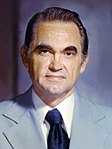
Back انتخابات الرئاسة الأمريكية 1968 Arabic Eleccions presidencials dels Estats Units de 1968 Catalan ھەڵبژاردنی سەرۆکایەتیی ویلایەتە یەکگرتووەکانی ئەمریکا (١٩٦٨) CKB Præsidentvalget i USA 1968 Danish Präsidentschaftswahl in den Vereinigten Staaten 1968 German Elecciones presidenciales de Estados Unidos de 1968 Spanish انتخابات ریاستجمهوری ایالات متحده آمریکا (۱۹۶۸) FA Yhdysvaltain presidentinvaalit 1968 Finnish Élection présidentielle américaine de 1968 French הבחירות לנשיאות ארצות הברית 1968 HE
| |||||||||||||||||||||||||||||||||||||
538 members of the Electoral College 270 electoral votes needed to win | |||||||||||||||||||||||||||||||||||||
|---|---|---|---|---|---|---|---|---|---|---|---|---|---|---|---|---|---|---|---|---|---|---|---|---|---|---|---|---|---|---|---|---|---|---|---|---|---|
| Opinion polls | |||||||||||||||||||||||||||||||||||||
| Turnout | 62.5%[1] | ||||||||||||||||||||||||||||||||||||
| |||||||||||||||||||||||||||||||||||||
 Presidential election results map. Red denotes states won by Nixon/Agnew, blue denotes those won by Humphrey/Muskie, and orange denotes those won by Wallace/LeMay, including a North Carolina faithless elector. Numbers indicate electoral votes cast by each state. | |||||||||||||||||||||||||||||||||||||
| |||||||||||||||||||||||||||||||||||||
Presidential elections were held in the United States on November 5, 1968. Republican nominee, former vice president Richard Nixon, defeated both the Democratic nominee, incumbent vice president Hubert Humphrey, and the American Independent Party nominee, former Alabama governor George Wallace.
Incumbent president Lyndon B. Johnson had been the early frontrunner for the Democratic Party's nomination, but he withdrew from the race after only narrowly winning the New Hampshire primary. Eugene McCarthy, Robert F. Kennedy and Humphrey emerged as the three major candidates in the Democratic primaries until Kennedy was assassinated. His death after midnight on June 6, 1968, continued a streak of high-profile assassinations in the 1960s. Humphrey edged out anti-Vietnam war candidate McCarthy to win the Democratic nomination, sparking numerous anti-war protests. Nixon entered the Republican primaries as the front-runner, defeating liberal New York governor Nelson Rockefeller, conservative governor of California Ronald Reagan, and other candidates to win his party's nomination.
The election year was tumultuous and chaotic. It was marked by the assassination of Martin Luther King Jr. in early April, and the subsequent 54 days of riots across the nation, by the assassination of Robert F. Kennedy in early June, and by widespread opposition to the Vietnam War across university campuses. Vice President Hubert Humphrey won and secured the Democratic nomination, with Humphrey promising to continue Johnson's war on poverty and to support the civil rights movement.
The Johnson administration’s support for civil rights led to an erosion of Humphrey’s support in the South. This prompted a run by George Wallace, the former governor of Alabama, on the ticket of the newly-formed American Independent Party. Wallace campaigned in favor of racial segregation on the basis of "states' rights". His American Independent Party attracted socially conservative voters throughout the South, and drew further support from white working-class voters in the Industrial North and Midwest who were attracted to Wallace's economic populism and anti-establishment rhetoric. In doing so, Wallace split the New Deal Coalition, winning over Southern Democrats, as well as former Goldwater supporters who preferred him over Nixon.
Nixon chose to take advantage of Democratic infighting by running a more centrist platform aimed at attracting moderate voters as part of his "silent majority" who were alienated by both the liberal agenda of Humphrey and the ultra-conservative viewpoints of Wallace. However, Nixon also employed coded language to combat Wallace in the Upper South, where the electorate was less extreme on the segregation issue. Nixon sought to restore law and order to the nation's cities and provide new leadership in the Vietnam War.
During most of the campaign, Humphrey trailed Nixon significantly in polls taken from late August to early October, with some polls predicting a margin of victory of as high as 16% as late as August. In the final month of the campaign, however, Humphrey managed to narrow Nixon's lead after Wallace's candidacy collapsed and Johnson suspended bombing in the Vietnam War to appease the anti-war movement; the election was considered a tossup by election day. Nixon managed to secure a close victory in the popular vote on election day, with just over 500,000 votes (0.7%) separating him and Humphrey. In the electoral college, however, Nixon's victory was much larger; he carried the tipping point state of Ohio by over 90,000 votes (2.3%), and his overall margin of victory in the electoral college was 110 votes. This election was the first presidential election after the passage of the Voting Rights Act of 1965, which began restoring voting rights to Black Americans in the South, where most had been disenfranchised since the early 20th century.[2]
This was the last election until 2024 in which the incumbent president was eligible to run again, but was not the eventual nominee of their party. Humphrey was the last nominee who did not participate in the primaries as a presidential candidate until Kamala Harris, also in 2024. Nixon also became the first non-incumbent vice president to be elected president, something that would not happen again until 2020, when Joe Biden was elected president.[3]
As of 2024, this is the most recent election in which a third-party candidate won pledged electoral votes that didn't come from faithless electors. It is also the most recent election in which a Republican was elected president without winning Texas.
- ^ "National General Election VEP Turnout Rates, 1789-Present". United States Election Project. CQ Press. Archived from the original on July 25, 2014. Retrieved February 21, 2023.
- ^ "Voting Rights Act of 1965". HISTORY. Archived from the original on January 21, 2021. Retrieved February 1, 2019.
- ^ Azari, Julia (August 20, 2020). "Biden Had To Fight For The Presidential Nomination. But Most VPs Have To". FiveThirtyEight. Archived from the original on November 17, 2020. Retrieved January 26, 2021.
Cite error: There are <ref group=lower-alpha> tags or {{efn}} templates on this page, but the references will not show without a {{reflist|group=lower-alpha}} template or {{notelist}} template (see the help page).


